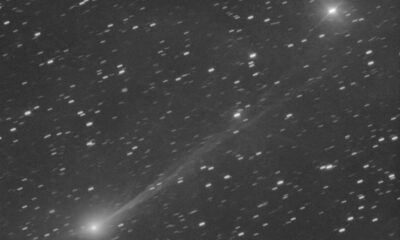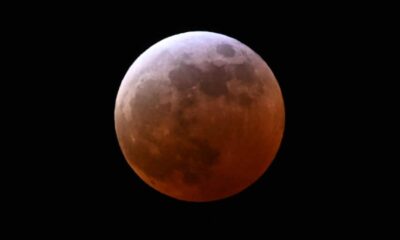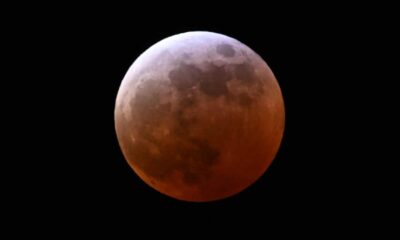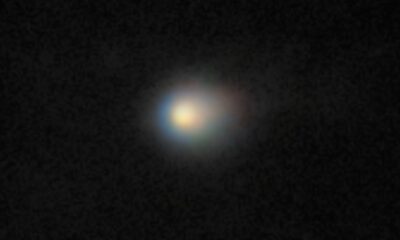Science
Scientists Excited as Interstellar Comet 3I/Atlas Approaches Sun

A new interstellar visitor, known as 3I/Atlas, is racing through our solar system, capturing the attention of scientists worldwide. Detected in July 2023, this object is traveling at approximately 61 km (38 miles) per second and is only the third confirmed interstellar object observed, following ‘Oumuamua in 2017 and 2I/Borisov in 2019.
The Hubble Space Telescope recently captured an image of 3I/Atlas, providing a unique opportunity for researchers to analyze its characteristics. “We’ve never had an object like this to study before,” said Dr. Rebecca Allen, co-director of Swinburne’s Space Technology and Industry Institute.
Understanding 3I/Atlas
The origins of 3I/Atlas remain a mystery. “We don’t know exactly where it came from, but it definitely came from outside the solar system,” explained Dr. Laura Driessen, a radio astronomer at the University of Sydney. The name “3I/Atlas” reflects its classification as the third interstellar object and honors the Asteroid Terrestrial-impact Last Alert System, the network of telescopes that discovered it.
Despite some speculation about potential alien origins, scientists largely believe 3I/Atlas is a comet. “There’s no evidence to point towards [3I/Atlas] being anything other than a really fun space rock that came from outside the solar system,” Driessen remarked.
In Hubble’s image, 3I/Atlas resembles a “fuzzy snowball,” a characteristic attributed to its coma, which forms as the sun heats the comet’s surface, releasing dust and gas. As it approaches the sun, scientists anticipate that the chemical signatures of elements from beyond our solar system will become more apparent. “We can use a tool called spectroscopy to understand exactly what that material is,” Allen noted.
The Journey Ahead
Researchers estimate that the diameter of 3I/Atlas is less than 5.6 km, with some estimates suggesting it could be as small as 320 meters. As it travels at over 200,000 km/h, it will pass through the inner solar system, specifically between the orbits of Mars and Earth, before flying past the sun.
This comet is on a hyperbolic orbit, meaning it is not gravitationally bound to the sun and will exit the solar system after its closest approach. 3I/Atlas is expected to reach its nearest point to the sun between October and December, coming within approximately 210 million kilometers. NASA reports that the closest it will get to Earth is about 270 million kilometers. “We’re not really sure where it’s going to end up until it comes around from the other side of the sun,” Stoitsis said.
As for visibility, 3I/Atlas is currently faint but is expected to brighten as it approaches the sun. Con Stoitsis, comet and meteor director at the Astronomical Society of Victoria, mentioned that it may soon be visible to large amateur telescopes. However, he cautioned that it would likely appear as a smudge. “This is definitely not one of those bright comets that are visible with small telescopes and binoculars,” Stoitsis added.
The ongoing study of 3I/Atlas represents a significant opportunity to expand our understanding of interstellar objects and the conditions that may exist in other solar systems. With its arrival, scientists are eager to uncover the secrets this comet may hold.
-

 Politics4 weeks ago
Politics4 weeks agoSecwepemc First Nation Seeks Aboriginal Title Over Kamloops Area
-

 World5 months ago
World5 months agoScientists Unearth Ancient Antarctic Ice to Unlock Climate Secrets
-

 Entertainment5 months ago
Entertainment5 months agoTrump and McCormick to Announce $70 Billion Energy Investments
-

 Science5 months ago
Science5 months agoFour Astronauts Return to Earth After International Space Station Mission
-

 Lifestyle5 months ago
Lifestyle5 months agoTransLink Launches Food Truck Program to Boost Revenue in Vancouver
-

 Technology3 months ago
Technology3 months agoApple Notes Enhances Functionality with Markdown Support in macOS 26
-

 Lifestyle3 months ago
Lifestyle3 months agoManitoba’s Burger Champion Shines Again Amid Dining Innovations
-

 Top Stories2 months ago
Top Stories2 months agoUrgent Update: Fatal Crash on Highway 99 Claims Life of Pitt Meadows Man
-

 Politics4 months ago
Politics4 months agoUkrainian Tennis Star Elina Svitolina Faces Death Threats Online
-

 Sports5 months ago
Sports5 months agoSearch Underway for Missing Hunter Amid Hokkaido Bear Emergency
-

 Politics5 months ago
Politics5 months agoCarney Engages First Nations Leaders at Development Law Summit
-

 Technology5 months ago
Technology5 months agoFrosthaven Launches Early Access on July 31, 2025



















